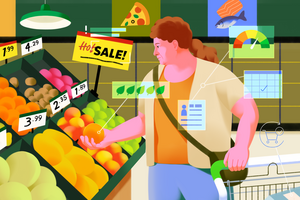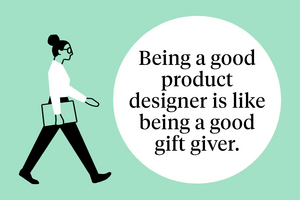Imagine you are the CEO of a Fortune 500 consumer products company. Things are going well, very well, for you: your recent product launch was a smash, investors are enamored, and Wall Street is singing your praises.
But you know you cannot rest on your laurels forever. Your company needs to gear up for the coming product launch, and you need to decide on your next—as the marketing world calls it—brand extension.
That decision can be crucial to your company’s bottom line, says Kelly Goldsmith, an assistant professor of marketing at the Kellogg School. Brand extensions occur any time a company like Häagen-Dazs, known for its classy ice cream, opts to “extend” itself into a related product category like, say, frozen yogurt; or when Nike breaks into a brand new sports category as they did with skateboarding in 2002.
Traditionally, the objective has been not to stray too far from a brand’s persona, yet still strive to find the next new thing—and to do this often, because any consumer company has to grow.
“I was reading a statistic that said something like 70 percent of all new products are brand extensions,” Goldsmith says. “Brand extensions are most of what we are going to get when we go to the grocery store, the convenience store, etc. Most of the new products we are seeing are extensions of successful brands.
“Brand extensions are most of what we are going to get when we go to the grocery store, the convenience store, etc. Most of the new products we are seeing are extensions of successful brands.” — Goldsmith
“So the question comes up as to how you can increase the likelihood that your brand extension will be successful, which is very important to firms, as you can imagine, because though they’re building off an existing brand, there’s still a lot of money and investment that goes into launching any new product.”
A Question of Fit
One thing firms concern themselves with is fit. This is the notion that, say, Heineken brewing company had best not roll out a new popcorn product because consumers will expect it to taste like beer (participants actually expressed this concern in a real experiment). Another example? “Exxon ice cream,” Goldsmith suggests playfully, laughing at the notion that consumers will think, “I don’t want gasoline in my milk.”
But while an extremely low-fit concept like gas-flavored ice cream is a no-no, what about a concept that is just lower fit?
“If you read the seminal work on brand extensions from the early 1990s, it reads like a primer on the importance of the fit between the extension and the brand,” Goldsmith points out. However, for every high-fit extension, like Mr. Clean making mops, “there are also lower-fit extensions that exist and are successful in the marketplace. Harley Davidson, a motorcycle brand, went into apparel and fragrances. Those products were lower fit yet still successful.”
There are even more eyebrow-raising brand extensions, Goldsmith notes, like BMW skateboards, Jacuzzi kitchen sinks, and Starbucks wine, available in the java giant’s coffee cafes. Goldsmith says she and her research collaborators Tom Meyvis, an associate professor at New York University and Ravi Dhar, a professor at Yale University “started thinking that if low-fit extensions ‘always fail’—which is what the prior literature implicitly suggested—there shouldn’t be any low-fit extensions in the marketplace because they shouldn’t sell and companies should learn [from their failures].”
But in fact, BMW skateboards and Jacuzzi sinks have not been failures. The researchers began to wonder, “Maybe there are some factors we haven’t explored that could actually increase consumers’ likelihood of accepting low-fit extensions.”
The trio of researchers decided that perhaps consumer-products companies had missed something by testing new product concepts under laboratory-like conditions, where study participants rate products on percentile scales and consider proposals in abstract terms. What, they wondered, would get people thinking like they were actual shoppers in a store?
The Shopper Mindset
The trio chose to experiment with visual cues and brand comparisons. Visual cues emphasize physicality: you can inspect the product just as you would in a store. When customers feels like a product already exists, the researchers thought, they might be less concerned about whether it fits with the brand and more concerned with whether it fits with their needs.
Similarly, brand comparisons allow participants to consider a particular brand’s product in a more natural context: next to the product’s competitors. Take, for instance, a fictitious cottage cheese made by Häagen-Dazs. When presented alongside other cottage cheeses, you might be less inclined to see it as odd and more inclined to consider it just as you would the other cottage cheese options.
In a series of experiments, Goldsmith and her colleagues gave participants choices between higher-quality but lower-fit brand extensions, like Haagen-Dazs cottage cheese, and lower-quality but better-fitting brand extensions, like store-brand cottage cheese. They found support for their hypotheses that visual cues and brand comparisons would increase participants’ preferences for the higher-quality, lower-fit brand extensions. One study found, for instance, that “[s]imply providing the outline of a deodorant stick increased the choice share of a Nike deodorant from 50% to 80%” over store-brand deodorant.
Another study found that participants rated themselves as more likely to purchase the higher-quality product, such as an Applebee’s Mexican cookbook, over the higher-fit product, such as a Taco Bell Mexican cookbook, when participants were asked to rate or compare adjacent brands than when they were asked to rate brands separately.
“If you are a brand like Nike or Häagen-Dazs, or one of these very large national brands associated with quality, and you want to make money by extending that very successful brand even further.” — Goldstein
“When you give people pictures, preferences shift because [people] are focused on quality—they are more interested in quality than fit,” Goldsmith says. “Whereas when you show the brand concept without pictures … the reaction is more focused on fit than quality. Allowing product comparisons leads to the same results.”
“Make It Imaginable, Make It Real”
CEOs and marketing teams can take away a “straightforward” lesson from these findings, Goldsmith says: “If you get your brand-extension concept out of the lab and into the store, all of those [benefits from visual cues and brand comparison] are taken care of.”
“If you are a brand like Nike or Häagen-Dazs, or one of these very large national brands associated with quality, and you want to make money by extending that very successful brand even further—to new [but] lower-fitting categories—what our research shows is that you really need to show people what that product looks like and show it to them in the context of other brands in that category.”
The implication, she says, is that advertisements for Häagen-Dazs cottage cheese on its own might not be enough. Instead, the company would need to get the product into grocery stores and give consumers taste tests to “make it imaginable, make it real.”
Lower-fitting extensions are not the products you to display in isolation, Goldsmith explains. You want to surround them with like products so people can see them as part of that product category. This removes any ambiguity about what, say, Häagen-Dazs cottage cheese would look like and lets customers focus on quality.
There is, of course, a flip side: for lower-quality brands that want to introduce a brand extension—Goldsmith offers the examples of McDonald’s and Taco Bell—“you might want to keep it in isolation; you don’t want to put it in the context of other brands and potentially highlight low-quality associations.”
Meyvis, Tom, Kelly Goldsmith, and Ravi Dhar. 2012. “The Importance of the Context in Brand Extension: How Pictures and Comparisons Shift Consumers’ Focus from Fit to Quality.” Journal of Marketing Research, 49(2): 206–217.


